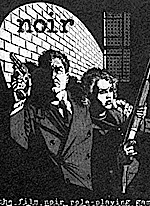 By Jason Inglert, Jack Norris, and Chris Werner
By Jason Inglert, Jack Norris, and Chris Werner
Published by Archon Gaming
236 Pages
$24.95
A friend of mine tells me that there's a lot of academic discussion (re: red-faced arguing) about what exactly "noir" is. Is it a genre? Is it a style? Is it a movement?
Well, to be honest, I have no answer for any of that. All I know is that I love all the movies that fall into the nod category. I own a bookshelf full of Raymond Chandler, Dashell Hammet and Frank Miller's Sin City.
If you're in the same boat as me, Noir, the plm noir role-playing game is over 200 pages of fun. Granted, it's 200 pages of fun that could have used another spell check, but more on that later.
The book begins with a section called "What Is Noir?" The folks who wrote the book fill you in on the elements of noir in clear, simple language. They explain how noir is more about personal ethics than what is right and wrong, and sometimes it's real hard to tell the good guys from the bad ones.
It also explains that the best noir is timeless, occurring in a world that could be the 1940's, but could also be the 1990's; there's just not enough evidence to prove one era or another.
The setting itself is also ambiguous. Noir takes place in "The City" where the streets are wet from endless rain and the alleyways are long, thin and full of shadows. There's a war, although we're never sure which war, and the criminal element is evident at every turn.
Noir--the concept--is all about style. Mindless brutal violence just isn't enough for noir, but three thugs who barge in to the PI's office and threaten to break his legs if he doesn't hand over what they want sure is. It's the threat of violence that noir feeds on, keeping the audience on the edge of their seats and creating a sense of mystery that is absolutely necessary to the mood.
Noir--the game--does a strong job of conveying that style, and is full of ideas on how to implement it into your campaign.
The last third of the book is a vast store of NPCs and description of "The City." All of the neighborhoods (Chinatown, Little Italy, the Shantytown, etc.) get their own listings and include "The Players" (the folks with the pull), but the book keeps most of the city amhiguous, allowing the GM to personalize it to his own tastes.
Character creation is point-based. Players begin by picking a "Schtick" (a profession) and spending points on skills available to that Schtick. The catch is, you can pick more than one Shtick (picking a Shtick costs you points), which allows you to make that Clergyman/Femme Fatale you've always wanted. Of course, the rules state you have to explain to the Director (GM) every Shtick choice, which forces players to think about their character before they start marking up their character sheet.
The game system is a simple one, using d6s in combination with Traits and Skills. You add your Trait and Skill together, roll that many dice and try to beat a target number. I'm a big believer in the philosophy of making the game system emulate the setting, and this one just doesn't.
Granted, it's meant to be simple so it doesn't spoil the rich and delicate atmosphere of Noir, so I'm not too disappointed. The game system is simple, easy to learn and while it may be uninventive, it works.
However, there is one aspect of this book that I have a legitimate complaint about, and that's the editing. There are a lot of errors. A whole lot. I counted at least one for every two pages, many of which could have been avoided with a simple spell check program. It's a small disappointment, but it's there.
The art of Noir ranges from adequate to exquisite. You'll recognize some big names like Howard Chaykin, Ken Meyer, Jr., and Bill Sienkiewicz, but there are others who deserve some real recognition (my personal favorite is Skott Khilander: bravo, sir! ).
Archon games has big plans for Noir, including a series of fiction anthologies, an adventure anthology called Adventures in the Shadows, and the Director's Pack (which supposed to include a "gas station map" --you know, the kind you unfold and can never refold again).
There's a lot of promise in Noir. If you can ignore typos, and value style over system, then you'll be hanging out with molls, dolls, torpedoes and gumshoes in no time.
More Reviews:
Back to Shadis #35 Table of Contents
Back to Shadis List of Issues
Back to MagWeb Master List of Magazines
© Copyright 1997 by Alderac Entertainment Group
This article appears in MagWeb (Magazine Web) on the Internet World Wide Web.
Other military history articles and gaming articles are available at http://www.magweb.com